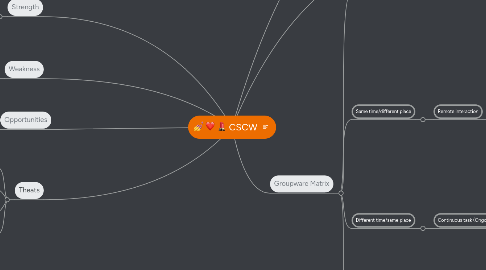
1. Strength
1.1. Cost Savings
1.2. Long-term collaboration
1.3. Group participation and contribution
1.4. Flexibility
1.4.1. Synchronizing schedules
2. Theats
2.1. Hard to Achieve Critical Mass
2.2. Hard to deal with Exception-handling
2.3. Designing for low-frequency events
2.4. Evaluate
3. Weakness
3.1. Extra Requires
3.2. Limits of informed intuition
3.3. Avoiding other social & motivational pitfalls
3.4. Designing with an adoption process in mind
4. Opportunities
4.1. Breaking geographic restrictions
4.2. Using the range
5. Region
6. Challenges in Reaserach
6.1. Different meanging
6.2. Identifying user needs
6.3. Evaluation and measurement
7. Groupware Matrix
7.1. Same time/same place time
7.1.1. Face to face interaction
7.1.1.1. Roomware
7.1.1.2. Shared tables
7.1.1.3. Wall displays
7.1.1.4. Digital whiteboards
7.1.1.5. Electronic meeting systems
7.1.1.6. Single display groupware
7.1.1.7. Group Decision Support System
7.1.1.8. decision rooms
7.2. Same time/different place
7.2.1. Remote interaction
7.2.1.1. Electronic meeting systems
7.2.1.2. Video/voice conferencing
7.2.1.3. File & screen sharing
7.2.1.4. Real-time groupware
7.2.1.5. Messaging (instant messaging, email, chat)
7.2.1.6. telephoning
7.3. Different time/same place
7.3.1. Continuous task (Ongoing task )
7.3.1.1. Team rooms
7.3.1.2. Large displays
7.3.1.3. Post-it
7.3.1.4. Warrooms
7.3.1.5. Shift work groupware
7.3.1.6. Project management
7.4. Different time/different place
7.4.1. Communication and Coordination
7.4.1.1. Electronic meeting systems
7.4.1.2. asynchronous conferencing
7.4.1.3. Blogs
7.4.1.4. Emails
7.4.1.5. Workflow management
7.4.1.6. Version control
7.4.1.7. Group calender
7.4.1.8. Bulletin boards
7.4.1.9. Cooperative hypertext & organisational memory
7.4.1.10. Structured messaging systems
